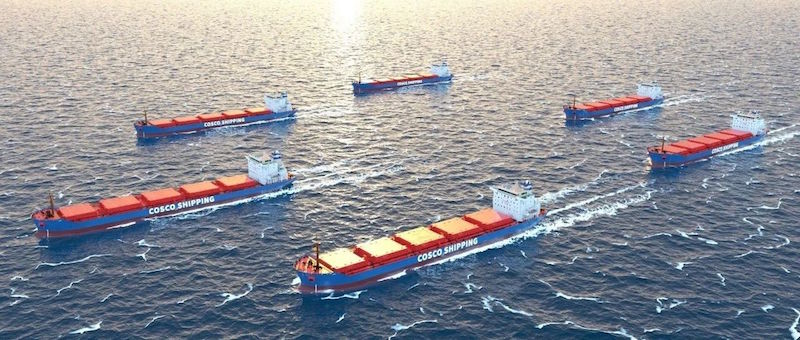Sixty years ago, a defining chapter of the Mercedes-Benz commercial vehicles history began: on 5 March 1959, the Stuttgart brand presented the new “short-nosed” truck, initially in models L 322 and L 327 (medium-weight class) as well as L 337 (heavy class). The short-nosed vehicles were internationally very successful and important for the strategy of what was then Daimler-Benz AG for internationalisation after the Second World War. They continued to be built until the 1990s. In total, almost a million short-nosed vehicles were built – either as complete trucks or as parts kits for construction abroad.

In 1959, Mercedes-Benz successfully steered a middle course with the completely new truck generation: the classic commercial vehicles with a long bonnet and freestanding wing are not replaced in one go by forward control vehicles with engines located completely under the cab, but are instead replaced by the “short-nosed vehicle“. Here, the engine is only partially beneath the cab and the vehicle has a striking front with a short, round bonnet. The design of the short-nosed vehicle with integral headlamps and wings clearly takes style elements from the Mercedes-Benz self-supporting chassis-body structure saloons of the time.

Mercedes-Benz presented the short-nosed truck to the press on 5 March 1959 in Stuttgart with models L 322, L 327 and L 337. The first two belong to the medium-weight class, which were built in the Mannheim plant. The L 337 with an around 300 millimetre longer bonnet belongs to the heavy class and was produced in the Gaggenau plant. Just like their predecessors, the new models are also available as forward control vehicles (air compressor) ex factory. The P in the model designation stands for Pullman and indicates the comparably comfortably equipped and spacious forward control cab. The forward control design impresses with its short vehicle length and high agility compared to bonnet vehicles with the same effective area and payload. However, the noise and heat emissions from the engine located below the cab is still very high and without the tilting cab, only introduced years later, the accessibility of the engine for maintenance work is poor.

Optimum compromise
The short-nosed vehicle design is the optimum compromise between the classic bonnet lorry and forward control: the L 328 short-nosed vehicle introduced in 1961 (L 911 from 1963 after a change of model designation) has a turning circle 2,400 millimetres smaller than the comparable L 312 long-nosed vehicle. At the same time, the noise and heat of the engine is a lot less noticeable in the cab compared to the LP 328/LP 911 forward control. There is sufficient space for a third seat between the driver and passenger. Finally, the engine is more accessible for maintenance work. Mercedes-Benz describes the benefits in the press kit for the International Motor Show in Frankfurt am Main (IAA, 17 to 21 September 1959) as follows: “The modern cab made entirely from steel, hung in rubber at four points, with side-hung and wind-up windows, has a large, single-part panoramic windscreen and two rear windows made from safety tempered glass. The engine compartment firmly closed against the cab and perfectly shields against all engine noises. All maintenance work to the easily accessible engine is carried out from the outside.“

The development of the short-nosed truck mediated between new legal requirements and the trust of the customer in the renowned Mercedes-Benz commercial vehicle technology. After all, bonnet trucks are popular, but their critics see them as too long and too heavy. The West German transport minister at the time, Hans-Christoph Seebohm, wanted to change that in the mid-1950s. On 22 March 1956, the “Regulation for the amendment of the road traffic act and road traffic regulations (weights and measures)” is published in the German Federal Law Gazette to be valid from 21 March 1956 (colloquially known as “Seebohm’s law“). It has significant implications. For trucks and trailers newly registered from 1 January 1958, the total length (13 metres for semitrailers and 14 metres for juggernauts instead of the previous 20 metres) and the permissible gross vehicle weight (a maximum of 24 tonnes as standard instead of the previous 40 tonnes) were to be dramatically limited.

Mercedes-Benz reacted to this challenge with the development of the LP 333 forward control model, which was built from 1958 to 1961 and was a three-axle 16-tonne truck with two steered front axles, commonly known as “the millipede“. This comparably light three-axle vehicle cleverly exploits the regulations for towing vehicle weights: whilst two-axle trucks may now only weigh up to twelve tonnes, the LP 333 has a permissible gross vehicle weight of 16 tonnes. if it is combined with one of the trailers approved before 1 January 1958, the permitted gross vehicle weight of the tractor-trailer is 32 tonnes. This results in a payload of more than 20 tonnes.

After severe protests, Minister Seebohm revised the timetable for his reform in as early as 1957. In 1960, he also shifted away from the most pronounced limitations. Nevertheless, it had become clear for German commercial vehicle manufacturers in the mid-1950s that future vehicles would have to deal with length and payload more efficiently than previous bonnet trucks had done.

Global success model
The Mercedes-Benz short-nosed vehicle model series implemented these difficult requirements with exceptional success. They were available as pickup trucks, tippers and tractor units, with all-wheel drive and, in the heavy class, also with three axles. The short-nosed vehicle chassis were set up for the fire service and municipal services such as street cleaning and refuse collection and formed the basis of many further uses, from cement mixers to special tankers. The short-nosed vehicles were also very successful when exported to countries all around the world. This made them an important pillar of internationalisation, which Daimler-Benz AG, as it was at the time, consistently followed after the Second World War.

Just how popular the trucks with the friendly, round short bonnet were with customers compared to the forward controls at the time can be seen with a look at the sales figures: the most successful short-nosed vehicle amongst the complete vehicles is the model 322, which, after the reorganisation of model designations in 1963, was called model 1113. The numerical sequence stands for eleven tonnes permissible gross vehicle weight and an engine output of 96 kW (130 hp). As a short-nosed truck (L) and short-nosed vehicle with all-wheel drive (LA), more than 60,000 vehicles are built between 1959 and 1969. In the forward control versions LP and LAP, the combined total was fewer than 16,000 vehicles. If the medium-weight and heavy short-nosed vehicle model series are added together, almost one million vehicles were built by the end of the 1990s. This includes more than 650,000 complete trucks and chassis as well as around 300,000 parts kits. These “completely knocked down” (ckd) sets were delivered for assembly abroad. By far the largest order was 226,930 ckd sets of the L 1210, which were delivered to India between 1964 and 1979.

Over the course of the long construction period, Mercedes-Benz continuously adapted the model programme of the short-nosed vehicles to customer requirements. This included three-axle versions in the heavy class from 1963, the successive introduction of diesel direct injection from 1964 and the more generous cab from 1967. The reorganisation of the commercial vehicle production of Mercedes-Benz also took place in the short-nosed vehicle era: from 1965, it was gradually moved to the Wörth plant. From then on, the heavy and medium-weight short-nosed vehicles were no longer separately produced in Gaggenau and Mannheim, but instead at one location for customers all over the world.










